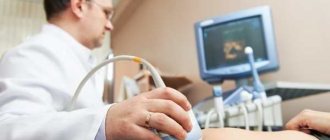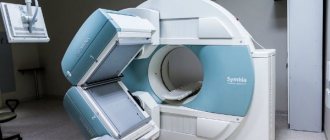Very often, such a wonderful period of waiting for a baby is overshadowed by the appearance of various dyspeptic disorders, causing in some cases periodic or constant discomfort, and in some cases - serious disorders accompanied by pain in the epigastric region. Diseases of the upper gastrointestinal tract (GIT) in pregnant women are characterized by a wide variety of symptoms and, in most cases, the absence of a clear clinical picture.
The last factor is associated with physiological changes occurring in a woman’s body:
- displacement of the stomach or intestines due to fetal growth;
- hormonal changes;
- sudden changes in taste preferences.
Gastroscopy during pregnancy is undoubtedly the most informative diagnostic technique, the implementation of which, however, is quite difficult for a woman. In this regard, gastroscopy should be used for diagnosis only for special indications or in the absence of any effect from previous treatment.
Is FGDS done during pregnancy?
Pregnancy is a crucial time in a woman’s life. During this period, you are supposed to take care not only of your own health, but also of your future baby. Difficulties with the stomach are common, and a medical examination is carried out to determine the cause of the disease. Expectant mothers are concerned about the safety of diagnosis using fibrogastroduodenoscopy.
An FGDS examination is indicated if the diagnosis cannot be established by other methods. The procedure is harmless, does not affect the fetus, and is prescribed for serious reasons.
The study using fibrogastroduodenoscopy makes it possible to study:
- Stomach condition.
- Mucous membrane.
- Intestines.
It is recommended to do gastroscopy in the first and second trimesters of pregnancy. In order for the study to proceed without complications and to be informative and accurate, the woman will need to prepare for the procedure. Consultation with a gynecologist is required.
Gastroenterologists say: the examination will not harm the woman. But external influences on the body during pregnancy are stressful. When the question arises about choosing a diagnostic method, the doctor takes into account all factors, the health status of the woman and child, and the course of pregnancy.
Preparing for the study: important points
Before performing a gastroscopy, a pregnant woman should be well prepared. Moreover, this preparation is both psycho-emotional and physical in nature. After the doctor has prescribed a test, the woman should not be nervous and should under no circumstances watch a video of this process. For those who are doing the procedure for the first time, it is better not to know the specifics of its implementation. The question arises, why? The procedure is not particularly pleasant, and looking at this spectacle is doubly not pleasant, and for a woman during pregnancy - three times. If a woman wants everything to go quickly and painlessly, she should not think about the procedure at all.
Physical preparation is based on the fact that it is required to refrain from eating 8 hours before swallowing the tube. You should also not drink, since any liquid will be removed from the stomach during vomiting, which can lead to the patient choking. Often the study is performed in the first half of the day, so you need to eat in the evening, but no later than 7 o’clock. The food should be light and not greasy so that it has time to be digested.
Smoking is prohibited before the study, and pregnant women are prohibited from engaging in such activities at all. Smoking during pregnancy puts a woman at risk of having an obviously sick child with various abnormalities. You should also not drink alcohol, which negatively affects not only the results of the study, but also the course of pregnancy.
The quality of the patient’s preparation for gastroscopy affects the accuracy of the results and the speed of the examination. In order for FGS to be successful and without complications, it is necessary to inform the doctor about what medications the patient is currently taking.
Indications for FGDS
An examination using fibrogastroduodenoscopy is performed if there are signs of digestive system disorders. Symptoms of diseases of the gastrointestinal tract (GIT):
- Feeling of nausea after eating;
- Heaviness in the stomach;
- Vomiting;
- Acute pain in the abdominal area;
- Increased body temperature;
- Heartburn, belching;
- Deterioration in health, poor appetite.
The listed symptoms are typical for pregnant women. But if the doctor suspects a serious health problem, endoscopy will help refute or confirm the presence of a pathological process in the body. In addition to these symptoms, FGDS is prescribed in the following situations:
- To accurately identify the focus that disrupts the normal functioning of the gastrointestinal tract;
- Ineffectiveness of other diagnostic procedures;
- Ulcerative colitis of the stomach or duodenum;
- A set of symptoms indicating difficulties in the digestive tract;
- Assumption of tumor growth;
- Before a planned operation on the abdominal organs;
- For signs of internal bleeding.
If it is not possible to identify the source of the disease by other methods, the doctor will refer you to an FGDS to diagnose the pathology and determine treatment.
Indications
The answer to a fairly common question, is it possible to do gastroscopy during pregnancy, is some limitation of the indications for this type of diagnosis. In a normal situation, the following regularly occurring dyspeptic phenomena that require clarification of the preliminary diagnosis may serve as indications:
- nausea or vomiting;
- heartburn;
- belching;
- constipation;
- pain in the upper abdomen.
During pregnancy, all these phenomena are considered to be subjective and treatment is carried out based on complaints and symptoms. The decision to prescribe gastroscopy is made based on an assessment of the body’s condition, based on the following clinical manifestations:
- intensity of pain symptoms;
- frequency of exacerbations;
- pain in the upper abdomen due to eating;
- pain on palpation of the abdominal area above the navel or on the right;
- increase or disappearance of pain after taking alkaline drugs;
- increase or disappearance of pain after vomiting;
- the presence of blood in vomit or feces.
Due to the increased emotionality that characterizes a pregnant woman, the gastroscopy procedure is quite difficult to tolerate. Increased nausea, for example, with toxicosis, can play a certain role in the difficulty of inserting a gastroscope. Severe spasms caused by gagging can inadvertently cause damage to the mucous membrane. But since an alternative to gastroscopy can only be an X-ray examination, which is unacceptable during pregnancy due to the ability to have a negative effect on the fetus, in cases that are obvious from a diagnostic point of view, it is advisable to limit ourselves to symptomatic treatment with regular testing for occult blood.
Thus, the answer to the question whether pregnant women can have gastroscopy depends solely on a competent assessment of the course of the disease and the woman’s condition. In the latter case, the following factors are assessed:
- is there toxicosis?
- age of the pregnant woman;
- secretory function of the stomach;
- uterine tone.
Important! If bleeding from the upper gastrointestinal tract, tumor or stenosis of the upper stomach is suspected, gastroscopy is prescribed at any stage of pregnancy.
A complete blood count may also indicate the presence of occult bleeding.
Preparatory measures
Gastroscopy is an endoscopic examination of the esophagus, stomach and duodenum using a flexible tube with a camera at the end. Fibrogastroduodenoscopy of the stomach is a diagnostic procedure that is also used for biopsy, i.e. sampling tissue for research.
The gastroenterologist referring for FGDS warns of the need to prepare for the procedure. Preparation is carried out according to the following rules:
- Two days before gastroscopy of the stomach, you will have to give up spicy, fatty foods, chocolate, beans, and nuts. This is important if a stomach ulcer is suspected.
- It is prohibited to consume alcoholic beverages and medications containing ethyl alcohol.
- Dinner should be low in fat, exclude meat, fish, cheese, mayonnaise, foods with a lot of fiber (wholemeal bread, cabbage, radishes, beans). You can eat mashed potatoes, buckwheat, oatmeal, cheese, stewed chicken meatballs, soup, juice. It is not advisable to eat more after dinner.
- On the day of gastroscopy, you should not eat or drink.
- Do not smoke before gastroscopy, this leads to the formation of gastric juice and complicates the study.
- On the day of the procedure, the use of tablets, syrups, and capsules of medications is prohibited (aspirin, warfarin and other blood thinners should not be taken 10 days before gastroscopy, they can cause bleeding).
- Tell your doctor if you have a tendency to allergies (especially to painkillers), or about the presence of diseases (heart failure, myocardial infarction, aortic aneurysm, diabetes mellitus, epilepsy, previous operations).
- It is recommended to undergo a blood clotting test.
- For fibrogastroduodenoscopy, take a referral, documents, necessary test results, comfortable clothes (robe), and remove jewelry.
What is gastroscopy
Gastroscopy is a diagnostic procedure during which, using a probe inserted into the stomach cavity, equipped with a fiber-optic system, the mucous surface of the entire upper gastrointestinal tract is examined. At the same time, a modern probe (gastroscope), having a small thickness (only 0.53–1.3 cm), is capable of not only illuminating and transmitting an image of the inspected surface to a video monitor, but also performing various manipulations, including:
- collecting a sample of gastric mucus for analysis;
- collection of a tissue fragment for histological analysis (biopsy);
- performing minor surgical procedures (for example, polyp removal).
Depending on the scope of the study, gastroscopy may include not only examination of the esophagus and stomach, but also the duodenum. The use of modern equipment allows us to minimize all possible risks of injury during diagnostics, however, the small probability of the following complications cannot be completely excluded:
- damage to the mucosa;
- infection;
- perforation of the wall of the stomach or esophagus.
Important! Gastroscopy should not be done during pregnancy if the previous examination was carried out less than 2 years ago and no serious pathologies were found.
Examination of the stomach cavity using a gastroscope
How is FGDS performed on pregnant women?
The procedure is carried out in a separate room.
- Before gastroscopy of the stomach, the pharyngeal mucosa is anesthetized (lidocaine is used, suitable for pregnant women).
- You need to lie on the couch on your left side. Doctors advise relaxing and controlling your breathing. When the patient is in a calm state, the procedure is easier and faster.
- You cannot talk, make sudden movements, or try to pull out the probe yourself. You can severely injure the mucous membrane and cause bleeding.
- Listen and follow your doctor's recommendations. The gastroenterologist will explain how the examination is carried out, what you may feel, and how to tell him if your health worsens during gastroscopy.
- The doctor will carefully advance the endoscope through the esophagus and stomach, monitoring the condition of the internal organs through the image of the monitor, which is part of the endoscope camera. Duration is 15 minutes. The procedure cannot be called pleasant, inconvenience is possible, but it is harmless to health.
Gastroscopy reveals pathologies and disorders:
- Hiatal hernia;
- Ulcers in the stomach and intestines, gastritis;
- Perforation of the mucous membrane, esophagitis;
- Enteritis;
- Duodenitis;
- Tumors of the esophagus and stomach;
- Varicose veins
After fibrogastroduodenoscopy, the woman goes home. Based on the examination results, the gastroenterologist makes a diagnosis and prescribes treatment. Drugs approved during pregnancy are used.
Before the procedure, the patient should be familiarized with the sequence of the procedure, contraindications and possible complications. The duration and cost of the study are announced. The doctor gives recommendations after the examination.
Tips after the procedure
A pregnant woman may have an unpleasant feeling in the throat after FGDS. The symptom is activated during the insertion of the probe, and the mucous membrane may be slightly injured. After a few days, the damaged tissue is completely regenerated, and the discomfort goes away.
During this period, it is necessary to increase vigilance, monitoring your well-being. Small microtraumas are a good place for a wide range of pathogenic bacteria. It is recommended to follow a number of rules after FGDS:
- Do not eat for 2-3 hours after the procedure.
- The drink is taken warm (hot drinks irritate the mucous membranes and can injure them even more).
- Food should not irritate the damaged mucous membrane.
- For rapid tissue regeneration, it is recommended to eat in small portions.
If you feel severe pain or the feeling of nausea and stomach discomfort does not go away, consult a doctor. The doctor will prescribe painkillers allowed during pregnancy.
Important! Do not take medications on your own; self-medication is dangerous for your health and for your unborn baby. Take pills and other medications carefully.
Preparatory activities
The question of whether pregnant women can have gastroscopy is approached individually. If there are no contraindications, then the patient begins the preparation stage for the examination. Gastroscopy is considered a safe procedure, therefore carrying a child is not a reason to refuse to have it performed. In order to do everything correctly and safely for the health of the expectant mother and baby, the woman must comply with all the requirements for preparing for gastroscopy.
The preparatory stage involves following the following recommendations:
- It is best to perform gastroscopy in the morning;
- The last meal before FGDS should be 6–8 hours before, so that the food has time to be completely digested;
- if the stomach is empty, this will allow a more accurate diagnosis and a better picture of what is happening inside;
- You should not drink 1 – 2 hours before the procedure.
The issue of alcohol and tobacco consumption is not discussed. No sane pregnant woman would smoke or drink.
Restrictions on gastroscopy
If a woman is pregnant, but is concerned about possible stomach problems, then the doctor must first verify the presence or absence of contraindications to gastroscopy.
Regarding restrictions, you need to know some important points:
- Gastroscopy may be prescribed if a pregnant woman experiences stomach problems and complains of unpleasant symptoms.
- It is impossible to make a diagnosis based on external signs, since the symptoms of gastrointestinal tract pathologies are largely similar to each other, regardless of the specific disease.
- Gynecologists advise doing gastroscopy at the end of the first trimester or at the beginning of the second, which ensures minimal exposure of the probe to the fetus.
- If we compare gastroscopy with radiography, then FGDS is much safer for pregnant women, while X-rays are strongly not recommended during pregnancy.
- Pregnant women are allowed to do FGDS if severe symptoms of gastritis or ulcers appear, since side effects in this case are extremely rare.
- Individual intolerance to anesthesia and allergies do not allow gastroscopy with its use. Many women easily tolerate the examination without pain relief.
- In the last weeks of pregnancy, it is not recommended to insert a probe due to the greater degree of threat to the fetus.
- In case of diseases, including chronic ones, the doctor determines individually whether a woman can have a tube inserted.
Even if the patient felt discomfort in the form of a sore throat or stomach after the procedure, there is no need to panic prematurely. This is normal. This condition usually lasts no more than 2–3 days and goes away on its own. If the pain does not subside and increases, then be sure to consult a doctor for help.
Contraindications
The diagnostic method of gastroscopy does not harm the body and health of a pregnant woman. In some cases, the procedure is postponed or alternative examination methods are used:
- FGDS of the stomach is not done if there is severe pain in the gastrointestinal tract during an exacerbation of a chronic disease. This creates a risk of complications.
- The doctor takes into account the condition of the woman and child, the course of pregnancy, and what week the pregnancy is. If there are prohibitions from the gynecologist, it is better not to conduct an FGDS examination.
Fibrogastroduodenoscopy during pregnancy is not an easy procedure. But diagnosing using this method makes it possible to correctly identify the disease and prescribe a course of treatment. Pregnancy is not a contraindication to FGDS. An experienced specialist and a positive attitude of the expectant mother will help carry out the procedure in an informative and painless manner.
After FGDS
What can you do after an FGDS and what can’t you do? Since the mucous membrane of the oral cavity and gastrointestinal tract has been severely irritated, it is not recommended to eat for two to three hours. Half an hour after it ends, you can drink warm water. The doctor will recommend an infusion or solution that will speed up the restoration of pharyngeal tissue. As a rule, the next day the woman does not feel any discomfort.
Gastroscopy during pregnancy is not a simple procedure for a woman. However, it gives the most accurate and reliable result. This allows you to prescribe the correct treatment. Since the baby’s health completely depends on the mother’s health, you need to overcome all fears and concerns and undergo an examination with a positive attitude (the sooner the better). Moreover, pregnancy itself is not a contraindication to FGDS.
Endoscopic picture of gastrointestinal pathologies
The most common pathologies of the upper gastrointestinal tract during pregnancy, for which gastroscopy is indicated, include the following diseases:
- chronic gastritis;
- stomach and duodenal ulcers;
- gastroduodenitis.
Chronic gastritis
In more than 70% of cases, the cause of the development of chronic gastritis is the bacterium Helicobacter pylori, which has the unique ability not only to survive in the acidic environment of the stomach, but also to change the pH of the environment, causing damage to the mucosa. These microorganisms also play an undoubted role in the development of stomach cancer. However, even if Helicobacter pylori is detected during the examination in a pregnant woman, antibacterial therapy cannot be carried out, since drugs used to suppress the activity of bacteria can have a negative effect on the development of the fetus.
When conducting a gastroscopic examination, the following signs are observed on the surface of the mucosa:
- swelling;
- slight vulnerability;
- hyperemic areas;
- severe mucus formation;
- erosions, which are lesions of various shapes (usually oval or round), with altered mucosa and swollen and hyperemic edges.
Certain information about the state of the stomach in chronic gastritis can be obtained using ultrasound without resorting to gastroscopy. An ultrasound scan on an empty stomach can reveal swelling of the stomach wall and the intensity of mucus formation.
Important! Gastroscopy, if the development of chronic gastritis is suspected, is prescribed only if there is no effect from the previously prescribed treatment.
Endoscopic image of chronic gastritis at different stages
Gastroduodenitis
If chronic gastritis is considered to be a precancerous condition, then chronic inflammatory processes of the duodenum have similar symptoms to peptic ulcers and are often classified as a pre-ulcerative condition.
In this case, the main symptom of the disease is pain, which is constant and intensifies after eating. Most often, gastroduodenitis is diagnosed in the 1st trimester of pregnancy and 1 month before birth.
When diagnosing chronic duodenitis, gastroscopy has no alternative. As with chronic gastritis, the mucous membrane of the duodenum is covered with foci of hyperemia, up to 2 cm in diameter and protruding above the surface of the edematous mucosa. Small areas of hemorrhage may also be present.
Peptic ulcer
Exacerbation of peptic ulcer disease during pregnancy is quite rare, since changes in hormonal levels have a beneficial effect on the restoration of connective tissue, which promotes the healing process. However, the possibility of exacerbation cannot be completely excluded.
When visualizing the inner surface of the stomach and duodenum, a gastric ulcer looks like a round crater, one edge of which is usually smoother and the other is deeper. A duodenal ulcer rarely has a regular shape; it is usually polygonal or slit-like with a shallow bottom, swollen edges and necrotic plaque on the surface. A fairly large area of tissue around the ulcer has a swollen appearance, is very hyperemic and bleeds easily.
Gastric ulcer on gastroscopic image
Nausea and vomiting
Pregnant women often experience symptoms of nausea and vomiting. In the early stages of pregnancy, almost 65% have these clinical signs, and in the later stages, 45% of women report these symptoms. Excessive vomiting of pregnant women can occur with paradoxical weight loss and with water and electrolyte imbalance.
In most episodes of vomiting in pregnant women during FEGDS
no pathological changes were found. Only in two women was an organic basis for these symptoms found. Also, in most women, antiemetic therapy and the use of proton pump inhibitors, which reduce acidity, eliminated symptoms of nausea and vomiting.
This treatment is considered by doctors to be relatively safe and very effective. Therefore, many experts believe that it is better to take these drugs for these conditions and not bring the matter to endoscopy. If we talk about excessive vomiting, it goes away after the 20th week of pregnancy. If symptoms persist and therapy is ineffective, endoscopy can be performed in the second trimester.
Without endoscopy, it is also possible to reliably diagnose Helicobacter pylori infection by determining antibodies to the microbe in blood serum and stool.
However, one of the serious indications for
FEGDS
is gastrointestinal bleeding, which is accompanied by vomiting “coffee grounds” and black stools. Such patients in these cases have a picture that requires urgent endoscopic surgical interventions.
In addition, if a cancerous tumor is suspected and there is an increasing difficulty in swallowing within 1-2 weeks, an endoscopy must be performed.
Quite rarely, but it does occur, bleeding from varicose veins of the esophagus. The disease is rare because it reduces fertility, that is, the ability to conceive, but there are episodes of such bleeding in pregnant patients with cirrhosis, liver fibrosis, portal obstruction, or liver failure developing in the third trimester.
The worsening of portal hypertension during pregnancy develops due to an increase in blood plasma. 30% of patients with portal hypertension develop esophageal varices, and the rest develop bleeding from varices.
What is the gastrointestinal tract research process?
The FGDS procedure is one of the most accurate diagnostic techniques for studying the digestive system. The procedure is indicated for patients who exhibit symptoms such as abdominal pain, heartburn, as well as nausea and belching. A gastroscopic examination is carried out to identify the causes of the development of these symptoms. Gastroscopy has many advantages over other research methods. The disadvantage of such a study is that the procedure is not very pleasant, as it contributes to the development of gag reflexes when swallowing the probe.
The principle of the study is that a probe, which is an elastic hose with a camera at the end, is inserted into the patient through the oral cavity. This tube is inserted through the esophagus and directed to the stomach and, if necessary, to the duodenum. The doctor watches a picture of what is happening inside the patient on the monitor. In this way, it is possible not only to identify the location of the ulcer or tumor, but also to carry out medicinal treatment.
Based on the FGS results, the doctor makes a diagnosis and prescribes appropriate treatment. It should be noted that the effectiveness and possibility of recovery depends on the timing of diagnosis of illnesses. The sooner measures are taken to cure a particular disease, the more effective the recovery process will be. Gastroscopy during pregnancy is no less important, especially if a woman has indications for it.
If there is a need, the doctor takes mucus from the stomach, which will be examined in detail in the future. This is done in most cases, which makes it possible to differentiate benign types of neoplasms from malignant ones.
A study that is carried out with a special apparatus and shows the condition of the gastrointestinal tract (gastrointestinal tract) - gastroscopy of the stomach. This analysis is carried out if there is a suspicion of pathology in the digestive organs. Gastroscopy (EGD, FGDS, esophagogastroduodenoscopy, esophagogastroscopy, fibrogastroscopy) is performed by a gastroenterologist. For this purpose, a special instrument is used - a gastroscope. Before diagnosis, proper preparation is needed, and the procedure itself is performed according to a certain algorithm.
If a woman during pregnancy cannot tolerate such a procedure, then the doctor decides on the possibility of performing FGS in her sleep. During such a study, the woman will sleep under the influence of special drugs, and thus will not feel discomfort. But before administering anesthesia, the anesthesiologist must assess the woman’s condition. If you are allergic to the composition of anesthetics, severe complications can develop, leading to miscarriage and death of the child.
Recommendations for pregnant women
Women are interested in whether it is possible to do gastroscopy while expecting a baby. Gastroenterologists assure that the procedure itself is safe. However, like any other medical intervention, it is stressful for the body. A pregnant woman is sensitive to all changes that occur. The doctor must explain to the expectant mother the need for FGDS. If the benefit for the mother is obvious, then the procedure must be done as soon as possible.
Many women are afraid of discomfort during FGS. Discomfort is usually associated with insertion of the device into the throat. The probe irritates the mucous membranes. The gag reflex is often provoked. The solution to the problem is the use of a local anesthetic. Doctors prefer lidocaine in spray form. This drug works on the principle of freezing. The effect occurs within a few minutes. The sensitivity of the mucous membranes decreases, the patient does not experience discomfort. Lidocaine is safe for both the expectant mother and her child.
An alternative to such pain relief is immersion in medicated sleep. In this case, unpleasant sensations are completely eliminated. Before performing a procedure using this technology, an experienced anesthesiologist must assess the health status of the pregnant woman.
What is FGDS?
FGDS is a diagnostic method for studying the condition of the internal surface of the gastrointestinal tract. Unlike FGS (fibrogastroscopy), it allows you to examine not only the esophagus and stomach, but also the duodenum.
The essence of fibrogastroduodenoscopy is that a special flexible tube ending in a chamber is inserted into the esophagus through the oral cavity. The surface of the organs is displayed on the monitor as the probe moves through the digestive tract. If necessary, a specialist has the opportunity to take material from the walls of organs for subsequent analysis. The procedure can last up to half an hour. After completion, the doctor processes the data received and makes a diagnosis.
We recommend reading: Use of Diprospan for arthrosis of the joints. Diprospan in injections: instructions on how long you can inject the medicine
How to behave after the examination
In order to recover as quickly as possible after gastroscopy, a pregnant woman needs to follow these rules:
- Half an hour after FGDS, you need to drink 1-2 glasses of liquid. In this case, water is supplied at room temperature. The fact is that too hot or cold liquid can cause irritation of the mucous membrane.
- Eating is allowed only 2 hours after the procedure.
- During FGDS, minor throat injuries are possible. However, they can cause discomfort and pain to a pregnant woman for several days. To avoid this, experts advise expectant mothers to drink 1 tsp. sea buckthorn oil before each meal. The remedy will be especially useful if it is painful for a pregnant woman to swallow after gastroscopy.
Now you know about the features of gastroscopy for pregnant women. We remind you that it is best to carry out FGDS in the early stages and only with appropriate indications. After all, vomiting and heartburn, which are symptoms of diseases of the gastrointestinal tract, may in fact be a normal option for one or another expectant mother.
Most often, gastroscopy during pregnancy is performed in the presence of several doctors, in addition to the diagnostician. This could be an obstetrician-gynecologist or an anesthesiologist who can quickly respond and provide assistance in unexpected situations. After completing the study, you should not eat for another 2-3 hours, since the mucous membrane of the gastrointestinal tract has been severely irritated due to instrumental intervention. For some time, a woman may experience nausea and a slight sore throat, which goes away on its own.
The doctor prescribes me to do FGS due to constant pain in the stomach. Duration 21-22 weeks. Has anyone done this procedure during pregnancy?
We recommend reading: Antral atrophic gastritis: causes, symptoms and treatment
Girls, in case someone cares. I did the FGS after all. They didn’t find anything criminal, but either because of nerves or something, I’m lying in bed today. My stomach hurts very much (it was very sick for 2 days before this). I don’t know what will happen next. For now I’m taking no-shpa and papaverine and stomach tablets.
Still, we had to endure it, we probably screwed ourselves up more. Nerves and stress make all this worse. Calm down, everything will work out, tune in to the fact that this is temporary. After giving birth, get treatment and recover. By the way, have you tried drinking chamomile? Pharmacy, in filter bags? She helps very well, but during B there are also different opinions about her.
The doctor prescribes me to do FGS due to constant pain in the stomach. Duration 21-22 weeks. Has anyone done this procedure during pregnancy?
Very often, such a wonderful period of waiting for a baby is overshadowed by the appearance of various dyspeptic disorders, causing in some cases periodic or constant discomfort, and in some cases - serious disorders accompanied by pain in the epigastric region. Diseases of the upper gastrointestinal tract (GIT) in pregnant women are characterized by a wide variety of symptoms and, in most cases, the absence of a clear clinical picture.
The last factor is associated with physiological changes occurring in a woman’s body:
- displacement of the stomach or intestines due to fetal growth;
- hormonal changes;
- sudden changes in taste preferences.
Gastroscopy during pregnancy is undoubtedly the most informative diagnostic technique, the implementation of which, however, is quite difficult for a woman. In this regard, gastroscopy should be used for diagnosis only for special indications or in the absence of any effect from previous treatment.











